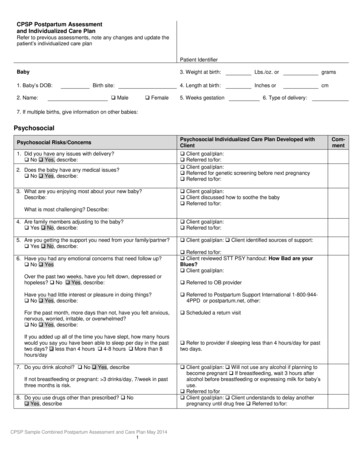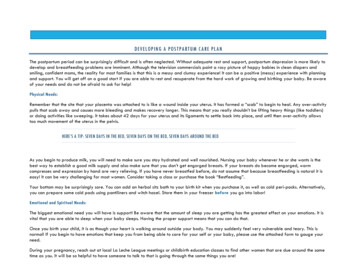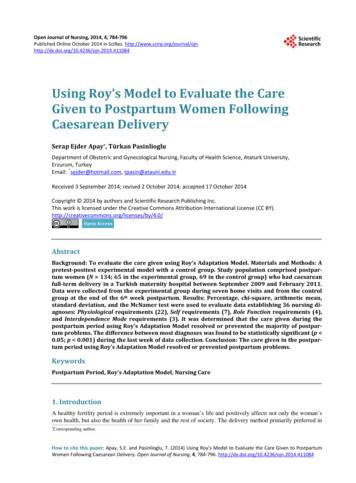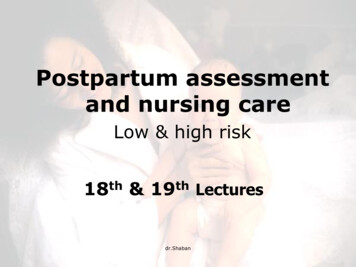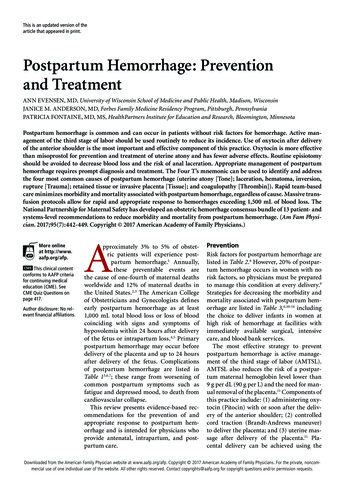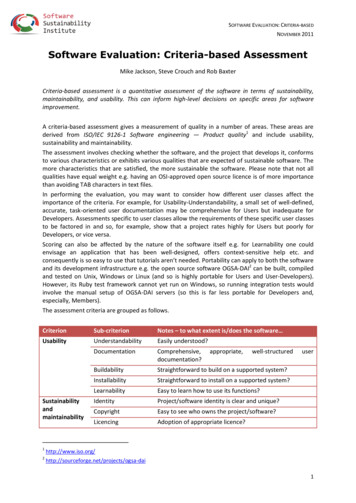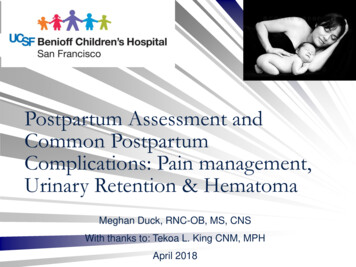
Transcription
Postpartum Assessment andCommon PostpartumComplications: Pain management,Urinary Retention & HematomaMeghan Duck, RNC-OB, MS, CNSWith thanks to: Tekoa L. King CNM, MPHApril 2018
Objectives Physiology and Assessment Physiologic Changes Immediately FollowingBirth Normal Lab Values During the PostpartumPeriod Postpartum Assessment and Care Evidence-Based Care Practices Skin-to-Skin care Delayed Cord Clamping Early Initiation of Breastfeeding
Objectives Common Complications in the First 72 hoursPostpartum Pain Urinary Retention Hematoma
“The greatest factor influencing awoman’s transition to the stressful role ofmotherhood seems to be the help shereceives following childbirth” (Romito P,1989)
The Postpartum Period Begins after delivery of the placenta and lastsuntil the reproductive organs have returned topre-pregnant condition, typically at 6-8 weeks The first hours after delivery are termed the fourthstage of labor.
The Fourth Stage of Labor The first hour postpartum is a critical time-periodsaturated with hormones that have profoundeffects Considered a “sensitive” period in whichmaternal-infant attachment can be stronglyaffected The first 24 hours is the immediate postpartumperiod The 3 months after delivery are termed thefourth trimesterCantrill RM 2014, WHO 1998
Goals of Postpartum Nursing Care Provision of: a safe physiologic transition relief of discomfort a supportive environment for maternal-infantattachment a supportive environment for the familytransition to parenthood resources for the woman
Objectives Physiology and Assessment Physiologic Changes Immediately FollowingBirth Normal Lab Values During the PostpartumPeriod Postpartum Assessment and Care Evidence-Based Care Practices Skin-to-Skin care Delayed Cord Clamping Early Initiation of Breastfeeding
Physiologic Changes ImmediatelyFollowing Birth Placental separation Uterine contraction shears placenta offendometrial wall Retroplacental hematoma formation furtherpushes placenta into lower uterine segment Clinical Punchline: Four classic signs of placentalseparation:1. Lengthening of umbilical cord2. Gush of blood3. Uterus becomes globular4. Uterus rises in abdomen
Physiologic Changes ImmediatelyFollowing Birth cont . Shivering is observed in 25-50% of women first30 minutes after birth Uterus is initially at umbilicus and firm topalpation Bleeding is normally 500 cc following a vaginalbirth Multiparous women tend to have 1-3 moreepisodes of sudden “gush” of blood with firmfundus in first 20-30 minutesRavid D 2001
Physiologic Changes ImmediatelyFollowing Birth cont Contraction of uterine muscle following delivery isnecessary to clamp off blood vessels supplyingthe placental site Uterine ligaments remain overstretched, andallow the uterus to shift from side to side Clinical Punchline: Uterine atony is the primary cause ofpostpartum hemorrhage Uterine position palpated abdominally can beused to detect urinary retention.
UTERINE ATONY
Postpartum Lab Values Hgb and Hct fluctuate secondary to changes inplasma volume, generally drops to nadir on PPday 2, and returns to normal by 1 week WBC is commonly elevated during labor andbegins to decline PP (WBC of 20,000-25,000common) Clinical Punchline Hgb, Hct, and WBC values are not reliablyreflective of anemia or infection in the first daysNichol B 1997, Parlow DB 2004
Postpartum Lab Values Liver enzymes AST and ALT should not change during normalcourse of pregnancy but they increaseintrapartum and return to normal values by 3weeks
Postpartum Lab Values cont Fibrinogen increased by 50% in pregnancy andreturns to pre-pregnant values by 2-3 weeks Risk for thrombosis remains until about 6weeks postpartum Clinical Punchline: Pre-eclampsia OB providers will watch trends of AST/ALT/Crand a CBC postpartum, follow trends and signs& symptoms
Objectives Physiology and Assessment Physiologic Changes Immediately FollowingBirth Normal Lab Values During the PostpartumPeriod Postpartum Assessment and Care Evidence-Based Care Practices Skin-to-Skin care Delayed Cord Clamping Early Initiation of Breastfeeding
Postpartum Assessment Subjective: Pain Other c/o Objective:Psychosocial:– Cultural Vital signsfactors Breasts– Maternal Abdomen and uterusadjustment Bladder– PTSD– Depression Bowel– PP LochiaPsychosis Perineum Legs
The 5th Vital SignPain is thought to be the 5th vital sign andwe need to assess for its presence withevery set of VS as well as prn.
PAIN Subjective/Objective Assessments: Pain should be characterized by‒Position‒Degree‒Radiating‒Associated symptoms‒What makes it better? Worse? Example: Is this laceration pain that is centered inperineum and increases with movement or ahematoma that is characterized by increasingpain unrelieved by any position?
Pain cont Afterpains decrease in frequency after the first few days, andusually are associated with:‒Breastfeeding‒Multiparity Rx is Ibuprofen 400-800 mg taken ½ hr beforenursing If pain unresolved with Ibuprofen may considerNorco (5 mg Hydrocodone and 325 mgAcetaminophen) NTE 4g/day of AcetaminophenDeusen AR 2011, Nauta M 2009
Non-Steroidal Anti-inflammatory Drugs(NSAIDS) Three types available Tylenol:‒Anti-pyretic and analgesic Aspirin:‒Anti-inflammatory, antipyretic andanalgesic Ibuprofen:‒Anti-inflammatory, antipyretic andanalgesic
NSAIDs NSAIDs have a “ceiling effect:” Increasing dosagebeyond a certain point will not analgesia, but will toxicity Mechanism of action is via inhibition ofprostaglandin formation that Initiates platelet aggregation, starts inflammation Contraindications Risk for active bleeding (inhibits platelets) Hx of gastric bleeding or ulcers Asthma: Can cause bronchoconstriction Allergy to aspirin
World Health Organization AnalgesicLadderWorld Health Organization
Post Operative Pain: MultimodalAnalgesia Using analgesics that have different mechanismsof action to potentiate effectMultimodal analgesia impoves pain control andminimizes adverse side effects NSAIDs and opiates affect pain via differentmechanisms Opiates: work at dorsal horn, no effect oninflammation NSAIDs decrease inflammation and stoptransmission at the site of injuryBuvanendran A 2009
Multi-Modal Analgesia: Mechanism ofAction
Post Operative Pain: Multi-modalAnalgesia Multimodal analgesia is“dose-sparing” and allowslower doses of opioid (30-40%) Works best with scheduleddosing rather than PRN Avoids playing “catch up”Buvanendran A 2009
A Note About Acetaminophen Acetaminophen is often hidden in short actingopioids such as Tylenol with Codeine, Norco,Percocet Maximum daily dose of acetaminophen is 4g. Combination products have recently beenreformulated so the maximum dose ofacetaminophen per tablet is 325 mg
A Note About Codeine Some women are ultra-metabolizers of codeine andthey may need higher doses to achieve pain control Codeine is metabolized to morphine in the liver Morphine accumulates in breast milk and there arecase reports of newborn overdose secondary to highlevels of codeine metabolites in breast milk Codeine may decrease infant sucking vigor andalertness Codeine is not recommended for postpartum pain ifother analgesics are availableLam J 2013, Madidi P 2009, Koren G 2006
Other subjective assessments Patient mood Affect Bonding with baby/skin to skin Support into motherhood
Psychosocial AssessmentCultural factors and expectationsMaternal adaptation to parenthoodFamily adjustmentEmotional recovery from birth PP Psychosis PP depression PTSD
PTSD: How Often do Women have aNegative Birth Experience?20-30% of women report “traumatic experience”following childbirth5-7% express dissatisfaction with birth 2-4months after birthSoet JE 2003, Beck CT 2004 , Waldstrom U 2004
Postpartum Physical Assessment4/19/2018
Breasts: Anatomical Changes Engorgement: Day 2-4 (range 1-7 days) Increased vascularity, edema Enlargement of the lobules as a result of increase inthe size of the alveoli Resolves in 48-72 hours May be associated with slight increase intemperature. Treatment: WASHED green cabbage leaves, icepacks prn, NSAIDS, nursing through discomfort,warm showersHurst NM 2007
Clinical Punchline Engorgement is a combination of breast milkand increased vascularity. Therefore, pumpingto decrease pain and swelling will only stimulatethe production of more milk and can exacerbateengorgement
Breasts Possible Problems:1. PE findings that impede breastfeeding– Nipple type or engorgement makes latch hard– Cracks or bleeding that causes too much painto breastfeed2. Breastfeeding assessment: Maternal/infantpositioning and latch that may impede success Subjective/Objective Assessments Redness and/or Engorgement Nipples‒ Protruding, flat, inverted‒ Nipples cracks or bleeding
Assessment of the Nipple
Breasts: Lactogenesis II Lactogenesis I is the development of the abilityto produce and secrete milk which occurs in thesecond half of pregnancy Lactogenesis II is the initiation of copious milkproduction/secretion Triggered by drop in circulating progesterone,elevated prolactin, and requires oxytocin formilk ejection Can occur 60-100 hours postpartum‒Delayed following cesarean section
Hormonal Control of Milk Synthesisand Milk Ejection Prolactin: Milk production Oxytocin: Milk ejection frommyoepithelial cells around alveoli
Breasts cont Goal: The mother demonstrates ability to feed infantsuccessfully. The 1st episode of breastfeeding should occur assoon as possible after birth (within the first 1hr isideal), while the newborn is still alert. 24 hr rooming in should be encouraged No bottles should be given to the newborn unlessbottle feeding is feeding decision of choice byparent or medically necessary
Newborns should be encouraged to BF at leastevery 2-3 hrs, with as much time at breast eachfeed as possible Supply and demand Power of skin to skin Use the latch scoring system to assess feeding40Postpartum April 20184/19/2018
Breasts Assessment/ Latch Score
Abdomen: First the Uterus Possible Problems Uterine atony that causes hemorrhage Use uterine position to assess for retained clot orfull bladder Subjective/Objective Assessments: Firm or Boggy Position: midline or deviated to right or left Uterine Involution: Fundal height in relation toumbilicus and symphysis. Normal findings are: Immed. After birth: at U or 1 cm above umbilicus 24 hours after birth: 1 cm below umbilicus 72 hours after birth: 3 cms below umbilicus
Fundal Massage-importance of bimanual massage
Abdomen: Uterus cont Nursing Actions Uterus:‒Vigorous massage to express clots only asneeded‒Gentle massage to stimulate uterinecontractility?‒Oxytocin is more effective than massage‒ Assist to void within first hour after birthClinical Punchline: Indications for physician evaluation include: Pulse and/or B/P Bleeding not resolved with massage orexpression of clots
Abdomen: Incision Possible problems: Infection Incision not approximated Subjective/Objective Assessments: Induration or redness around incision, notifyclinician and draw line around redness to markextension as it is observed Area of oozing or gaping in incision: Notifyclinician
Abdomen: Bladder Possible Problems1. Urinary Retention: 150 cc post-residualvolume2. Incomplete emptying3. UTISubjective/Objective Assessments: Urinary output: Use of catheter or hat Frequency of voids and voiding pattern Incontinence present?Abdominal Exam: palpate uterine displacement
Abdomen: Bladder cont . Goal: Spontaneous voiding resumes by 6 to 8 hours Urinary output: first void more than 200 cc Nursing Actions: Assist with first void within first hour after birth‒Bedpan if needed‒Pain med prior to ambulating‒Run water‒Void in shower or bath‒Peppermint oil prn‒Catheterize if the above measures fail
Void Reminders If patient is nursing, remind her to void beforeeach breastfeeding session. If not, simply have her postpartum routine be notwaiting more than 2-3 hours in between voids.
Bowel Possible Problem: Several factors increase risk forconstipation postpartum: Lack of normal diet during labor Prenatal vitamins Pain from perineal sutures Pain medications Lax abdominal muscle tone Nursing Action/Education Bowel movements usually resume 2-3 days PP Review effects of opioid medications Ensure pain relief from laceration or hemorrhoids
Lochia cont . Subjective/Objective Assessments: Type Amount Odor Clots Assessing amount Scant: 1 in. on menstrual pad in 1 hour Small: 4 in. stain on pad Moderate: 6 in. on menstrual pad in 1 hour Heavy: saturated menstrual pad in 1 hour Excessive: saturated pad in 15 minutes
Lochia Possible Problems Hemorrhage Infection Signs of retained clot Diagnosis Slow steady bright red bleeding indicates cervicallaceration Periodic gushing of darker red bleeding indicatesuterine atony Increasing contraction pain, firm uterus that islarger than it should be, watery lochia suggestsretained clot
Lochia Rubra: Day 0-3rd or 4th day. Red discharge thatmay contain shreds of tissue and decidua Serosa: Usually lasts 4-10 days, but may lastlonger. The median duration is 22 days. 15% ofwomen have serosa at the 6 wk check up. Pink tobrown and more watery Alba: Usually lasts 7-10 days. Yellowish whitedischarge, non foulFletcher S 2012
Perineum Possible Problems1. Laceration not well approximated, no infection2. Labial edema that impedes urination3. Hemorrhoids4. Hematoma Subjective/ObjectiveAssessments Lacerations Hematoma Hemorrhoids
Perineum Subjective/Objective Assessments Approximation of edges
Postpartum Hematoma More likely in AMA With OVD: Forceps, Vaccum LGA, 4g or more Nulliparous Assess in recovery, q shift,and prn symptoms56Postpartum April 20184/19/2018
Lacerations First- tear of vaginal mucosa Second-tear into perineum Third-anal sphincter involved Fourth-includes tear of rectum
Perineum Nursing Care Ice to perineum x 24 hours. Icing perineum X 20minutes periodically may decrease edema.Pericare after each void/BM Sitz baths 3-4 x day after the first 24 hours Analgesia: Ibuprofen 400-800mg q 4-6hrs x 24-48hours with Norco if needed
Hemorrhoids Analgesia for Hemorrhoids:‒Topical Witch Hazel (Tucks)‒Topical corticosteroid‒Topical anesthetic (Lidocaine spray)59Presentation Title and/or Sub Brand Name Here4/19/2018
Pelvic Floor Fascial stretching and trauma to the pelvic floormay occur during the birth. Fascia does notalways heal or return to pre-pregnant state Clinical Punchline: Stress incontinence Kegel exercises daily
A deeper dive .assessment ofthe normal and abnormal4/19/2018
Cardiovascular and Respiratory Systems Autotransfusionfrom placenta: size of vascular bedis reduced by 10-15% 500-750cc blood immediately added to maternalcirculatory system Diuresisbegins about day 2 PP as extracellular fluidreturns to vascular circulation ClinicalPunchline: Pulse rate should remain normal or decrease Dramatic fluid shifts occur immediately postpartumthat increase the risk for orthostatic hypotension,pulmonary edema
Cardiovascular and Respiratory Systemscont. Cardiac output (CO) and stroke volume by 80% inthe first 10-15 minutes after birth and then return topre-labor values about an hour later CO remains high for the first 48 hours PP thenreturns to pre-pregnant values by 6 weeks PP Clinical Punchline:These dramatic shifts in blood volume can causeadverse outcomes in women with pre-existingcardiac disease, hypertension, and/or preeclampsia
Respiratory System Pulmonary edema Subjective/Objective Assessments: Breath sounds: Rales, rhonchi, wheezes, absenceof sound Respiratory rate: normal 12-20, 12 respiratorydepression O2 saturation as indicated, goal above 95 % Normal Findings: Breath Sounds: clear to auscultation bilaterally Respiratory rate normal, O2 sat above 95%
Renal System Urinary Tract and Bladder: GFR, renal blood flow, and plasma creatinine allreturn to pre-pregnant levels by 6 weeks PP Bladder capacity increases secondary todecreased intra-abdominal pressure and relaxedabdominal muscles Trauma to bladder/urethra may cause edema anddecreased bladder sensation first 24 hrs Anesthesia effects of decreased sensation can lastup to 24 hours
Renal System cont Urinary Output: Increases within 12 hrs postpartum‒Diuresis (rapid diuresis first 3 days)‒Diaphoresis (two months) Clinical Punchline: Mild proteinuria common for first 2-3 days Transient stress incontinence first 6 weekspostpartum is common Increased risk for urinary retention (diuresis andincreased urinary output) Increased risk for UTIs and pyelonephritisRogers RG 2007
Coagulation System Pregnancy is a “hypercoaguable state” Increased circulating concentration ofprocoagulation factors: VII, VIII, X, andfibrinogen are increased Vast amounts of tissue factor in placenta. Tissuefactor can initiate clotting sequence Clinical Punchline: Risk of venous thromboembolism is higher inthe postpartum period than during pregnancy
Coagulation System: Assessment for DVT Possible Problems: Deep vein thrombosis of superficial phlebitis Subjective/Objective Assessments Signs of DVT include:‒Redness or discolored skin‒Pain with standing or walking‒Swelling (one leg larger in diameter than theother)‒Warmth over affected site‒Homan’s has high false rate
Metabolic Changes Immune suppression followed by abrupt return ofimmune function postpartum predisposes women topostpartum thyroiditis which is transient hypo orhyperthyroidism. Usually develops 1-3 months postpartum Pregnancy-induced insulin resistance falls duringlabor and birth. insulin requirements of women with diabetes dropprecipitously in the immediate postpartum period Breastfeeding may potentiate risk for hypoglycemia
Skin Diastasis of the rectus may be evident, andusually is re-approximated by 3 monthspostpartum Striae will change from red to white and barelyvisible by 3 months postpartum Linea negra and chloasma will disappear within2-3 months
Cultural Factors and PersonalExpectations Postpartum period is important in multiplecultures Many cultures have rituals and proscribedbehaviors designed to protect the mother andinfant during this period “Doing the Month”: 40 days of rest andisolation Dietary restrictions Lochia may be considered “unclean” Possible bathing restrictions
Picture of Postpartum PTSD Identifies a traumatic event Flashbacks or nightmares about the event Unable to recall important aspect of the event Exaggerated startle response Hyperarousal Avoids reminders of event May want retaliation or sensitive to injustice Panic attacks, sweating, or palpitations May occur anytime in the early postpartumperiod
Picture of Postpartum Depression Depressed mood, tearfulness, hopeless andfeels empty inside Loss of pleasure in all daily activities Changes in appetite and weight Sleep problems Extreme fatigue or loss of energy Feeling of worthlessness or guilt
Difficulty concentrating and making decisions Suicidal ideation Usually occurs after 6 weeks, but may occur up toto 1 year postpartum75Presentation Title and/or Sub Brand Name Here4/19/2018
Postpartum Psychosis Onset typically occurs on the third postpartumday Observable Symptoms: Irritability Restlessness Crying spells and Sleeplessness Anger toward family members, including infant Anxiety Moodiness
Objectives Common Complications in the First 72 hoursPostpartum Urinary Retention Endometritis Thrombophlebitis
Case StudyWhen you Come on Shift 38 Y/O G3 P2, 41 3/7 weeks Prodromal labor x 24 hours. Labor augmentedwith Pitocin 5 min 2nd stage and NSVD of healthy baby boyover intact perineum Manual removal of placenta. EBL 600 mls IV Pitocin 20 units in 500ml Lactated RingersOrders Discontinue IV when stable Routine postpartum orders
Case Study (cont’d)This is your first postpartum exam 3 hours after herbirth She has voided once “a small amount” VS: B/P146/90, P 115, R 26, T 37.8ºC. DTR’s 2 , no clonus Fundus 2 fb above umbilicus, displaced to theright; firm Lochia moderate and soaked Chux pad Transient dizziness when standingA Penny for your thoughts
Urinary RetentionDefinition: Inability to void spontaneously and/orresidual volume 150cc after spontaneous void butno standard definitionIncidence may be as high as 14% after vaginal birthand 24% after cesarean sectionDelayed diagnosis and treatment can result inpersistent urinary retention (more than 1-2 weeks)Yip SK 2005, Kekre AN 2010, Liang CC 2007, Groutz A 2001
Urinary RetentionPredisposing factors Primiparity Operative vaginal delivery (damage to pudendalnerve) Catheterization before delivery Induction or augmentation of labor Prolonged 1st and 2nd stages Anesthesia (especially epidural and/or morphine) Episiotomy or severe lacerationComplications Injury to bladder neck innervationYip SK 2005, Kekre AN 2010, Liang CC 2007
Urinary RetentionNormal non-pregnant bladder capacity is 350450 cc. Desire to void usually at 150 - 200 ccWomen should be able to void by 2-4 hours aftervaginal birthYip SK 2005
Urinary RetentionSigns and symptoms: Suprapubic tenderness or no symptoms Inability to void even if she is up to bathroom orhaving frequent small amount voids Uterine fundus is high and displaced to oneside Excessive bleeding with clots Palpable bladderYip SK 2005
Urinary Retention: Nursing ActionsNon-intervention measures first!- Oral analgesics- Provide privacy- Warm bath- Peppermint oil (works 60% of the time forpostoperative retention by relaxing urethra)Some institutions recommend using ultrasoundand if bladder volume is 400 cc then move tocatheterizationYip SK 2005
Urinary Retention: Indwelling vsIntermittent Catheterization If catheter necessary, use Foley, what residualvolume requires indwelling catheter?—Few studies on this with small numbers ofwomen—In general if volume is 700 ccs, the likelihoodof needing a repeat cath is unlikelyIf you place an indwelling catheter, how long doyou leave it in place?If indwelling catheter is in place 24 hours,approximately 40% of women will develop a UTIYip SK 2005
UCSF Voiding Algorithm- an exampleVoid by 4hourspostpartum?yesnoPerformbladder scanRecord timeand amount offirst void *Amount of 400 mLRecord timeand amount ofsecond void *Amount of 400 mLStraight catheterizepatient, record timeand amount, notifyMD/CNMAble to void by4 hours afterstraight cath?(Give pt 2 hr more)Able to void by6 hr PP?yesRecord timeand amount offirst void *Record timeand amount ofsecond void *yesnoRecord timeand amount offirst void *Amount of 400 mLRecord timeand amount ofsecond void *Give patient 2more hoursnoStraight catheterizepatient, record timeand amount, notifyMD/CNMRestart algorithm. If stillunable to void, notifyMD/CNM, consider foleycatheter x 12-24 hr **Performbladder scanIf unable to void by 6 hrafter cath, notify MD/CNM, consider foleycatheter x 12-24 hr **Amount of 400 mLNotify MD/CNM,consider foleycatheter x12-24 hr **
Endometritis Definition: Endometritis: infection involving the mucosal ordecidual layer of the endometrium Endomyometritis: Infection that extends into themyometrium Parametritis: Infection that extends to pelvicstructures surrounding uterus Occurs in 1-3% of women following NSVD and10-50% following cesarean sectionBurrows LJ et al 2004
Endometritis Risk factors include: Cesarean birth Chorioamnionitis Diabetes FSE and/or IUPC Long labor with multiple SVE Obesity Postpartum hemorrhage Preterm birth PROM Retained placenta SmokingBurrows LJ et al 2004
Endometritis cont . Differential Diagnosis Surgical site infection, mastitis, UTI, DVT,aspiration pneumonia Signs and Symptoms: Fever 38* on any two days excluding the first24 hours Foul smelling lochia Elevated WBC count ( 20,000 mm3) Tachycardia Malaise, anorexia Chills associated with spike in temperatureKarsnitz DB 2013
Endometritis cont . Broad spectrum antibiotics that include coveragefor both anaerobic and aerobic bacteria Gold standard is IV Gentamicin and Clindamycin 900 mg Clinda q 8 hrs, 1.5 mg/kg Gentamycin q 8hrs 90% of women will have resolution of fever in 48-72hoursKarsnitz DB 2013
Endometritis cont . If no resolution of fever in 48-72 hours considercomplications: Pelvic abscess Septic thrombophlebitis Rarely: resistant bacteria or drug fever Treatment is considered successful when Afebrile for 24 hours if vaginal birth Afebrile for 48 hours if cesarean sectionKarsnitz DB 2013, Black LP 2012
Endometritis: Nursing Actions Check for drug allergies prior to administeringantibiotics Observe for signs of septic shock: Tachypnea, hypotension, tachycardia, oliguria Tylenol for fever prn
Endometritis: Nursing Actions Increase PO fluids Administer oxytoxics as ordered to facilitateuterine drainage Keep mother and baby together as much aspossible Prevent breast engorgement
Postpartum Case Study G3 P1, two days after emergency cesarean for fetalintolerance to labor On your initial assessment in the morning: Afebrile, vital signs stable, lungs are clear Dressing dry and intact, bowel sounds in fourquadrants Fundus firm midline and below umbilicus Lochia normal
Postpartum Case StudyYou take out her IV and help her get up to take ashower As she returns from the bathroom she says her leghurts On exam you note redness in one leg What do you think? What do you do next?
Thrombophlebitis Definition: Inflammation of a vein with formation of athrombus Superficial phlebitis: Common, benign, and not associated withpulmonary embolism Visible, often in varicose veins Hard , painful area along affected vein DVT Pain, redness, and edema but a vein is not visible.Redness and edema is widespread Associated with a risk for pulmonary embolism
Deep Vein Thrombosis (DVT) What is it? Inflammation of a peripheral vein withdevelopment of a thrombus Best understood as the activation ofcoagulation in areas of reduced blood flow Incidence has decreased with earlyambulation in the PP periodJames AH 2008, Jackson E 2011
Deep Vein Thrombosis (DVT) Pregnancy predisposes to DVT due to: Venous stasis from enlarge uteruscompression, and decreased vascular tone Hypercoagualibility Remember Virchow’s triad?‒Hypercoaguability‒Stasis of blood flow‒Endothelial injuryJames AH 2008, Jackson E 2011
Deep Vein Thrombosis (DVT)
Risk Factors for DVT Maternal risk factors:Pregnancy risk factors Obesity Multiparity Smoking Preeclampsia Hx ofthromboembolism Physiologic changes ofpregnancy Diabetes Age 35 years OCP when notpregnant
Risk Factors for DVT Labor risk factors Cesarean birth PPH Infection Immobilization
Superficial Thrombophlebitis versus DVTSigns and Symptoms of Superficial Thrombophlebitis Leg pain Localized heat Tenderness Knot or cord to palpation Inflammation at the site
Superficial Thrombophlebitis versus DVTSigns and Symptoms of DVT Possible temp elevation Mild tachycardia Abrupt onset with severepain that worsens withwalking or standing Generalized edema ofleg Pain with pressure oncalf Tenderness along theentire course of theinvolved vessel Possible palpable cord
DVT cont Unilateral edema and increase in legcircumference (More often left leg than right)Tenderness--usually confined to the calf musclesor over the deep veins in the thighThe pain and tenderness does not correlate withthe size, location, or extent of the thrombusWarmth or erythema of skin may be present overthe area of thrombosis
DVT cont Homan’s sign: Discomfort in the calf muscles onforced dorsiflexion of the foot with the kneestraight This sign is present in less than one third ofpatients with confirmed DVT It also is found in more than 50% of patientswithout DVT. It is therefore very nonspecific
DVT cont Prevention Early ambulation Antiembolic stockings Diagnosis Doppler ultrasound: Better at predicting iliacand femoral DVT and less effective inpredicting DVT in calf veins
Superficial ThrombophlebitisTreatment Treatment: Analgesia as needed Leg rest Ambulation is usually OK Nursing Actions Warm packs to affected area Slight elevation of leg Supportive stockings
DVT Treatment Treatment: IV Heparin then Warfarin X 6 weeks Analgesia as needed Leg rest, Ambulation when acute symptoms resolve Nursing Actions Warm packs to affected area Slight elevation of leg Supportive stockings Carefully assess other signs of bleeding Have heparin antidote available Extensive teaching about warfarin will be needed
Any questions before our bridge toEBP ?
Objectives Physiology and Assessment Postpartum Physiologic Changes Normal Lab Values During the PostpartumPeriod Postpartum Assessment and Care Evidence-Based Care Practices Delayed Cord Clamping Skin-to-Skin care Early Initiation of Breastfeeding
Delayed Cord Clamping Delay of 60 seconds or more before theumbilical cord is clamped and cut Results in transfusion of approximately 83-110mL of blood Associated with: Less anemia at 4-6 months, iron stores rates of NEC, IVH Stem cell transfusion More benefits for preterm infantsMcDonald SJ 2013, Rabe H 2012, ACOG 2012
After delayed cord clamping 113Presentation Title and/or Sub Brand Name Here4/19/2018
Delayed Cord Clamping Recommended by ACOG and AAP for allnewborns, especially preterm infants Nursing actions: Provide dry place for placement of newborn ator below level of placenta Assess and dry infant while waiting for the cordto be clamped, document time cord clamped Move to skin-to-skin contact after cord isclampedSchean P 2014
Skin-to-Skin Contact Early, continuous, and prol
Apr 19, 2018 · The first hour postpartum is a critical time-period saturated with hormones that have profound effects Considered a “sensitive”period in which maternal-infant attachment can be strongly affected The first 24 hours is the immediate postpartum period The 3 months after delivery a
